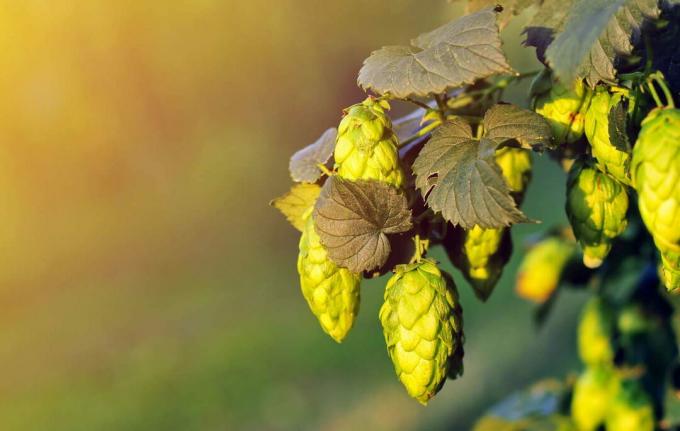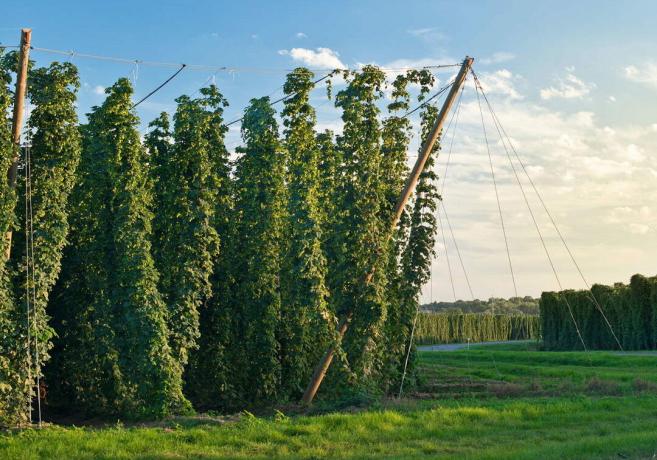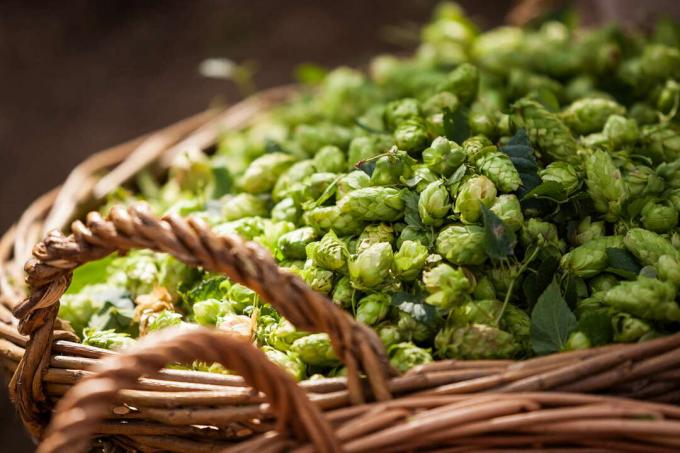Hops are mainly grown for brewing beer. We will show you what you have to consider in order to harvest plenty of hops in your own garden.
Of the real hops (Humulus lupulus) is a perennial and belongs to the hemp family (Cannabaceae). Originally it comes from our temperate latitudes in Central Europe. The climbing plant gives the beer its bitter taste and its antibacterial effect ensures a longer shelf life. Saint Hildegard von Bingen already knew this in the 12th century. Century. In addition to being bitter, the hops can also add a fruity-sweet or woody-spicy note to beer. In the meantime, a real fan base has formed who brew the most unusual taste beer creations from the multitude of hops thanks to the wide variety of aromas they contain. We will show you what to consider when cultivating the versatile taste artist hops. Because the hemp plant is quite maintenance-intensive and has high demands if the aromatic hops umbels are to be harvested in abundance in your own garden.
contents
- 1. Location
- 2. Multiplication
- 3. Watering and fertilizing
- 4. wintering
- 5. cut
- 6. Plant protection
- 7. harvest
- 8. storage
1. Location
The real hops are a sun worshiper. That is why it should be given a location in a southern location when growing in its own garden. It also needs nutrient-rich soil for its vigorous growth. It makes sense to work some compost into the soil every now and then.

Accordingly, a nutrient-rich substrate should be used when cultivating in pots. In addition, the location should not be too dry or too wet. When choosing a location, it should also be known that the hops develop rhizomes. These are underground shoot axes from which fresh shoots sprout every year. This allows hops to spread quickly in the bed and is difficult to drive away from its location. If it is dug up and cut rhizome parts remain in the ground, new plants can still regenerate and sprout again from these parts of the plant.
2. Multiplication
Exclusively one Propagation via cuttings should be done with hops. The hops are dioecious, which means that there are either female or male flowers on a plant. However, only unfertilized female inflorescences should be used for brewing beer. Unfertilized because they are richer in their characteristic aroma and easier to process. In the case of propagation by sowing, however, one cannot be sure whether the seeds are female or female Male is predisposed - it will very likely lead to the undesirable sexual mixed culture come. It is therefore advisable to reproduce the female plants using cuttings if the bitter hop cones are to be used. Young plants are also available in specialist shops, which you can be sure that they are female plants.

3. Watering and fertilizing
With a daily increase of up to 10 cm for each vine of a hop plant, it is not surprising that hops are very hungry and thirsty. The soil must always be kept moist. However, waterlogging must be avoided in any case. Particularly if the hops are grown in pots, you should ensure that they are regularly and well-balanced supplementary fertilization with a predominantly organic organic fertilizer. Our Plantura is ideal Organic universal fertilizer.
With increasing length of the hop shoots, the intervals between watering must of course be shortened. In early summer, in warm, dry weather, the bed should also be watered daily. That's why you'd better choose a larger pot or container to do the thirsty shrub and yourself a favor. It should be fertilized until it blooms.
4. wintering
Hops are perennials. This means that the above-ground parts of the plant die off completely each autumn and thus prevent a frosty death on their own. This is also clever, because it allows the hops to take advantage of the chance to transfer the valuable nutrients from the foliage to the underground rhizome. These are valuable reserves that provide the plant with enough power when it sprouts next spring. Incidentally, the rhizome is usually not affected by a period of prolonged frost.
5. cut
Winter pruning is not required for hops. But during the growth it is necessary to tie the up to 8 m long tendrils to a scaffold and let them climb upwards. However, only the three to four strongest shoots are selected here. All other shoots of a rhizome are cut off near the ground.

6. Plant protection
Aphids often feel very comfortable on hops. However, if you want to drive the rapidly growing small animal population away from your hop plants, you can of course use plant protection. However, more environmentally friendly home remedies often prove to be just as effective for growing in your own garden. Watering infested plants with a Nettle liquid manure or irrigation water to which a small splash of washing-up liquid has been added is usually enough to drive away the annoying sap suckers. But the hemp plant is also very popular in the mushroom kingdom: many varieties are often derived from Powdery mildew haunted. Care should be taken to select a variety that is as less susceptible or even resistant as possible for cultivation in your own garden.
7. harvest
When growing on a small scale in your own garden, the hop cones are plucked from the vines by hand. In commercial cultivation, the vines are cut just above the ground and completely torn from the climbing frame. Special machines then separate the tenons from the shoots. The correct harvest time is from late August to mid-September. You can tell when the time has come when the yellow powdery hop resins trickle out of the female inflorescences of the hops.
8. storage
After the harvest, the hop cones are dried. This serves to extend the shelf life without having to lose any aroma. Drying can take place in a light-protected room. It should be dark in order to preserve the greenish color of the cones and to protect the valuable ingredients from degradation by light.

However, if air drying does not go fast enough, remedial action can be taken in the oven. The cones can be dried at up to 80 ° C for one to two hours. When compressed into pellets and hermetically sealed, the shelf life and usability of the hop cone can be extended again.
Even if the growth of hops can take on immense proportions, there are still some things for them to consider successful cultivation in your own garden in order to bring in a high-yielding harvest of the green gold can.
Did you know that there are hundreds of different ones Hop varieties gives? We would like to introduce you to a few varieties - from bitter to fruity-sweet.



